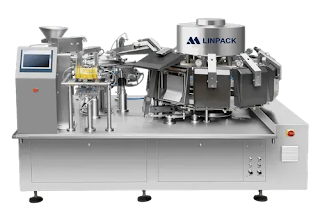A Beginner’s Guide to Using Linpack’s Vacuum Packaging Machines
Vacuum packaging has revolutionized the food, pharmaceutical, and industrial sectors by significantly extending product shelf life and enhancing quality. Among the top players in this space, Linpack stands out for its innovative, efficient, and user-friendly vacuum packaging solutions. If you’re new to using Linpack’s machines, this beginner’s guide will help you understand the basics, set up your machine, and operate it safely and effectively.
What Is Vacuum Packaging?
Vacuum packaging is a process that removes air from the packaging before sealing. This method prevents the growth of bacteria and mold, food packaging machine manufacturers slows down oxidation, and keeps products fresh for longer. It’s widely used for meats, dairy, seafood, baked goods, pharmaceuticals, and even electronics.
Why Choose Linpack’s Vacuum Packaging Machines?
Linpack offers a variety of vacuum packaging machines suitable for small businesses, medium enterprises, and large industrial operations. Here’s what makes Linpack stand out:
High durability and stainless-steel construction
Advanced vacuum technology for longer shelf life
Customizable sealing times and pressure settings
Compact designs that save floor space
Easy maintenance and user-friendly interfaces
Whether you’re packaging cheese in a dairy plant or sealing ready-to-eat meals, Linpack has a solution tailored to your needs.
Types of Linpack Vacuum Packaging Machines
Linpack offers several models, and choosing the right one depends on your product type, packaging volume, and automation requirements. Here are the most common types:
Chamber Vacuum Packaging Machines
Ideal for food items and medical tools, these machines seal items in a chamber for optimal air removal.External Vacuum Sealers
Perfect for businesses with low to medium packaging needs. They work with special vacuum bags and are easy to operate.Thermoforming Machines
These high-performance machines form packaging around products and are best suited for high-volume manufacturing lines.Tray Sealing Machines
Often used for pre-prepared meals or deli products, tray sealers vacuum and seal trays efficiently.
Setting Up Your Linpack Vacuum Packaging Machine
Here’s a step-by-step process to get your Linpack machine ready for operation:
1. Unpacking and Inspection
Once your machine arrives, carefully remove all packaging materials. Inspect for any physical damage and ensure that all accessories are included.
2. Power Requirements
Make sure your power supply matches the specifications on the machine’s label. Linpack machines typically require 220V single-phase or 380V three-phase power.
3. Placement
Place the machine on a flat, dry surface. granule packaging machines Ensure enough ventilation around the machine, especially near the pump area.
4. Oil Check (For Chamber Machines)
Some Linpack models come with oil-lubricated vacuum pumps. Check oil levels before operation and fill if necessary.
5. Initial Setup
Use the control panel to set vacuum time, sealing time, and cooling time. Start with the recommended settings in the user manual and adjust as needed.
How to Operate a Linpack Vacuum Packaging Machine
Operating a Linpack vacuum sealer is easy. Here’s a basic guide:
Step 1: Prepare Your Product
Place your product inside a vacuum-sealable bag. Make sure the bag is clean and free from folds in the sealing area.
Step 2: Position the Bag
Lay the open end of the bag over the sealing bar, ensuring it lies flat for a strong, airtight seal.
Step 3: Set Parameters
Use the digital interface to set the vacuum time (typically 20-40 seconds), sealing time (1.5–3 seconds), and cooling time (1–2 seconds).
Step 4: Start the Cycle
Close the chamber lid (or clamp the bag, depending on the machine). Press the “Start” button. The machine will remove air, seal the bag, and cool the seal before releasing the vacuum.
Step 5: Remove and Inspect
Once the cycle ends, open the lid and remove the sealed product. Check the seal for strength and consistency.
Maintenance Tips for Longevity
To ensure the long life of your Linpack vacuum packaging machine, regular maintenance is crucial:
Clean the machine daily with a soft cloth and non-corrosive cleaner.
Check the vacuum pump oil weekly and replace it as per the manual.
Inspect the sealing strip for wear and replace when necessary.
Clean the sealing bar to prevent residue buildup.
Schedule a quarterly inspection by a professional technician if operating in a high-volume environment.
Common Troubleshooting Tips
Problem: The bag isn’t sealing properly
Solution: Check sealing bar alignment, replace Teflon tape if worn, and ensure correct sealing time is set.
Problem: Weak vacuum
Solution: Inspect for leaks in the bag or chamber. Ensure the lid gasket is clean and oil levels are sufficient.
Problem: Machine won’t start
Solution: Confirm power supply, check fuses, and inspect emergency stop button.
Safety Precautions
Never touch the sealing bar immediately after a cycle – it gets hot.
Do not overload the machine.
Keep the machine dry and away from water sources.
Always switch off and unplug before performing maintenance.
Industries That Trust Linpack
Linpack serves a broad range of industries with tailored vacuum solutions, including:
Food Processing: For meat, poultry, seafood, dairy, and bakery packaging
Pharmaceutical: For sterile and contamination-free packaging
Hospitality & Catering: For sous-vide and portion control
Industrial & Electronics: For moisture-sensitive items
Final Thoughts
Linpack’s vacuum packaging machines are built with precision, efficiency, and user convenience in mind. Whether you're starting a small food business or scaling industrial production, these machines offer the right mix of automation, durability, and reliability.
By following this beginner’s guide, you can confidently set up and operate your vacuum packaging machine, ensuring your products remain fresh, safe, and market-ready. Linpack also offers exceptional after-sales support, training, and spare parts, making your investment even more worthwhile.
If you’re ready to streamline your packaging process, Linpack has the vacuum solution you need.
-p-500.webp)



Comments
Post a Comment